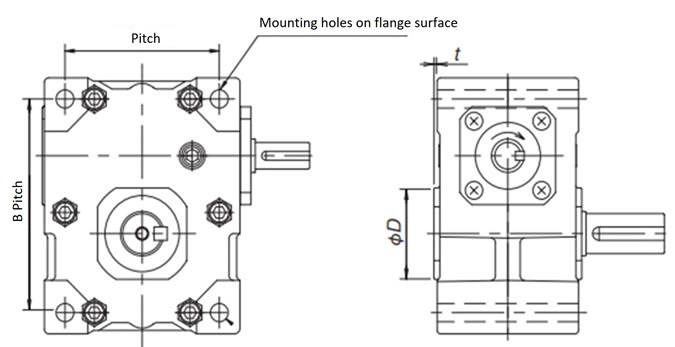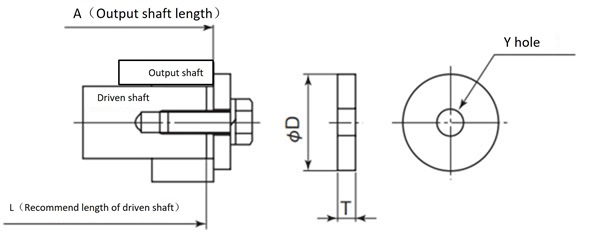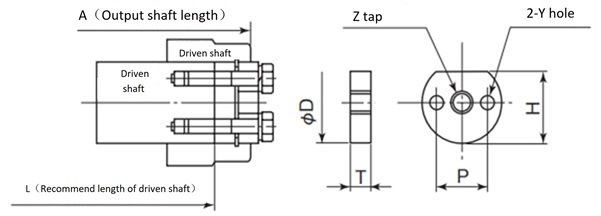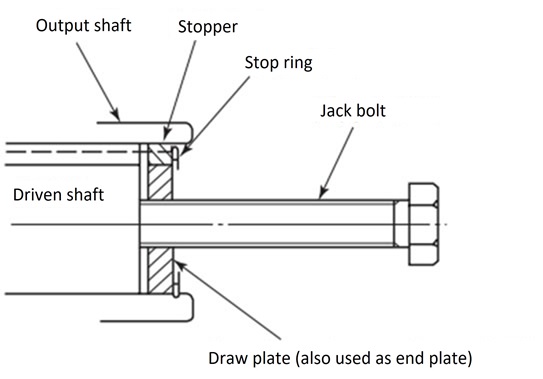Technical Data Reducers Worm Gear Reducers Handling
This section contains general information regarding the handling of the EWJ/EWJM(R)/EW/EWM(R), and SWJ/SWJM(R)/SW/SWM(R), and TD Series.
For more information, see the instruction manual provided with the product.
4. Mounting
The area of installation should have an ambient temperature of 0 to 40°C, be well-ventilated, low in humidity, and have little or no dust.
Avoid use in areas with corrosive, explosive, or flammable liquids and gases.
If the reducer is to be used outdoors, furnish a cover or similar protection to avoid direct exposure to rain.
- (1)When installing or removing the reducer from the driven shaft, make sure to shut off the power source before working.
- (2)Always use the lifting bolt on the top surface of the reducer housing when installing or removing it from the driven shaft. Never hook wires or slings to the input/output shafts.
- (3)Make sure the reducer is balanced and stable when installing or removing it from the driven shaft. Working with the reducer in an unbalanced position is extremely dangerous as it may turn over. Always maintain the reducer in a stable position.
- (4)Models SWJ25 to 63 and SWJM(R)35 to 63 do not have lifting bolts. Hold the reducer with both hands to keep it steady and parallel to the driven shaft while inserting or removing it from the driven shaft.
4-1. Solid output shaft type
Reducers with a solid output shaft are either foot-mounted (EWJ/EWJM(R)/EW/EWM(R)/TD-S), or flange-mounted (SW/SWM80 to 200).
4-1-1. Foot mount (EWJ・EWJM(R)・EW・EWM(R)・TD-S)
- ・Confirm whether the installation is standard.
- ・If the installation is non-standard, refer to the outline drawing or contact us as the volume of lubrication oil and the method of lubrication differs from the standard design.
- ・Install on a smooth flat installation surface that can easily withstand the weight of the equipment. The installation angle should be within ±1°.
- ・Use bolts compliant to JIS strength class 10.9T for installation
Recommended bolts for mounting
EWJ・EWJM Size EWJ25 EWJ35 EWJ42 EWJ50 EWJ63 EWJ70 Recommended bolts M6×15 M8×15 M10×20 M8×25 M10×30 M12×35 EW・EWM Size EW80 EW100 EW125 EW150 EW175 EW200 Recommended bolts M12×40 M14×45 M16×55 M20×60 M20×70 M24×80 TD-S Size TD125 TD150 TD175 TD200 TD225 TD250 TD280 TD315 Recommended bolts M16×55 M20×60 M20×70 M24×80 M24×80 M30×100 M30×100 M30×110 - ・Avoid installing in such a way that can cause the housing to become deformed.
- ・The reducer is filled with lubrication oil and plugged before shipment. The oil filling port is plugged to prevent leakage during transport. Make sure to replace the plug with the supplied pressure vent before usage. Otherwise, oil may leak from the oil seal due to high internal pressure, particularly if the unit is run continuously.
Note) EWJ25 to 70/EWJM42 to 70 (including double reduction models), and SWJ25 to 70/SWJM35 to 70: A pressure vent is not necessary and can be used as it is.
4-1-2. Flange mounting (EWJ25~42・EWJM(R)42・SW80~200・SWM(R)80~200)
Mount the reducer using the flange side of the housing. Observe these points.
1. SW/SWM(R) solid output shaft type
- (1)Use the positioning step on the housing and fix the reducer flange by using the tapped holes.
- (2)Install the reducer by adjusting the radial runout, and the connection and angularity of the input/output shafts.
- (3)Refer to the following table for recommended bolts and pitches for the flange surface of the reducer.
(Bolt size in table: Depth is tapping depth. )
Note) Always use the position step for positioning and fix the flange before connecting the input and output shafts. It may cause an unexpected load on the shafts and bearings, and shorten the reducer life time when the input and output shafts are connected at first.
Recommended bolt sizes for lange surface
Reducer size SW80 SW100 SW125 SW150 SW175 SW200 Bolt size M10 Depth 20 M10 Depth 20 M12 Depth 25 M12 Depth 25 M14 Depth 30 M16 Depth 30 Mounting PCD 180 205 255 300 350 380 Bolt quantity 6 6 6 8 8 8
2. EWJ25 to 42/EWJM(R)42
When mounting the reducer to the floor or wall, take note of the following:
- (1)Use the mounting holes provided on the flange surface to mount the reducer. The surface of the housing protrudes beyond the mounting surface of the reducer. Leave at least the amount of clearance (φD, t) shown in the drawing between the reducer and the mounting surface.
- (2)Install the reducer by adjusting the radial runout, and the connection and angularity of the input/output shafts.
- (3)Refer to the following table for recommended bolts and pitches for the flange surface of the reducer.
Note) Always fix the flange before connecting the input and output shafts. It may cause an unexpected load on the shafts and bearings, and shorten the reducer life time when the shafts are connected at first.

Clearance required between installation surfaces
| Size | ΦD | t |
|---|---|---|
| EWJ25 | 46 | 3 |
| EWJ35 | 48 | 1.5 |
| EWJ42 | 63 | 3 |
Mounting bolt quantity, size, pitch
| Size | Mounting bolt size | Pitch A |
Pitch B |
|---|---|---|---|
| EWJ25 | M6×60 four | 57 | 76 |
| EWJ35 | M8×80 four | 71 | 96 |
| EWJ42 | M10×90 four | 88 | 111 |
Recommended tightening torque
| Size | Tightening torque (N・m) |
Tightening torque {kgf・m} |
|---|---|---|
| EWJ25 | 4.9 ~ 5.9 | 0.5 ~ 0.6 |
| EWJ35 | 12 ~ 14 | 1.2 ~ 1.4 |
| EWJ42 | 24 ~ 27 | 2.4 ~ 2.7 |
4-2. Hollow output shaft type
There are three ways to prevent the reducer from rotating: torque arm mount, flange mount, foot mount (EW-H (hollow output shaft type) only). The recommended tolerance for the driven shaft is g7.
- (1)Before inserting the driven shaft into the hollow output shaft, make sure the outside of the driven shaft and the inside of the hollow shaft are free of scratches and dust.
- (2)To make insertion easier, apply grease or molybdenum disulfide to the driven shaft.
- (3)If the shafts fit very tightly, help the hollow shaft slide smoothly by tapping its opposite end with a plastic hammer. Be careful not to damage the oil seal.
- (4)Hollow shaft keyways are finished at JIS standard, and refer to the following table for key length.
Recommended length of driven shaft (Refer to Figures 1 and 2 below. )
| Series | SWJ | SW・EW | SW・EW・TD | TD | ||||||||||||
|---|---|---|---|---|---|---|---|---|---|---|---|---|---|---|---|---|
| Reducer size | 25 | 35 | 42 | 50 | 63 | 70 | 80 | 100 | 125 | 150 | 175 | 200 | 225 | 250 | 280 | 315 |
| Output shaft length :A | 60 | 70 | 80 | 108 | 128 | 130 | 148 | 174 | 200 | 250 | 270 | 290 | 320 | 356 | 404 | 454 |
| Recommended length of driven shaft :L | 58 | 68 | 78 | 89 | 109 | 106 | 122 | 146 | 170 | 220 | 238 | 258 | 272 | 303 | 344 | 386 |
4-2-1. Installation/removal of torque arm
1. Installation procedures
Note) Avoid using a line shaft to connect reducers with double input shafts.
- (1)Fix the torque arm to the reducer with bolts. Note) Tsubaki torque arms come with bolt set. Use a grade 10.9 or equivalent bolts when installing a torque arm.
- (2)Insert the reducer onto the driven shaft.
- (3)Fix the reducer to the driven shaft in the axial direction.
- ・SWJ25 to 42: Tsubaki recommends fi xing the end plate on the output shaft end. (Figure 1)
- ・SWJ50 to 70, SW80 to 200, EW80-H to 200-H (hollow output shaft), TD125H to 315H: Tsubaki recommends fixing the stop plate and end plate by using the snap ring groove on the hollow output shaft (Figure 2). (Refer to the hollow output shaft dimension details on the product page )
- (4)After finalizing the installation position of the reducer, fix the torque arm to prevent the reducer and driven shaft from rotating. Provide sufficient room so that the torque arm is free to move in the axial direction.
- Note) Do not fix the torque arm position before fixing it to the reducer. Doing so may damage the reducer. Follow the work procedure. (EW80-H to 200-H are with foot mounts. After fixing the output hollow shaft and driven shaft, set up the position of the bearing to support the driven shaft. )
- Note) The dimensions and outline given in Table 1 below are recommended for the end plate, which also function as a draw plate.
Fig. 1 SWJ25~42

Fig. 2 SWJ50~70・SW80~200
EW80-H~200-H・TD125H~315H

Table 1 Recommended end plate and draw plate dimensions
| Size | Output shaft hole diameter | Recommended plate dimensions | Bolt for plate (Spring washer ) |
Stop ring Size |
|||||
|---|---|---|---|---|---|---|---|---|---|
| ΦD | T | H | Z | Y hole | P | ||||
| SWJ25 | Φ12 | 16 | 4.5 | - | - | 5.5 | - | 1-M5×15 | - |
| SWJ35 | Φ20 | 26 | 6 | - | - | 9 | - | 1-M8×25 | - |
| SWJ42 | Φ25 | 32 | 6 | - | - | 9 | - | 1-M8×25 | - |
| SWJ50 | Φ30 | 29.6 | 9 | 25 | M12 | - | - | 1-M10×40 | C 30 |
| SWJ63 | Φ35 | 34.6 | 9 | 30 | M12 | - | - | 1-M10×40 | C 35 |
| SWJ70 | Φ40 | 39.6 | 12 | 34 | M12 | 2- 6.6 | 24 | 2-M6×40 | C 40 |
| EW/SW80 | Φ50 | 49.6 | 12 | 44 | M16 | 2- 9 | 30 | 2-M8×45 | C 50 |
| EW/SW100 | Φ55 | 54.6 | 14 | 48 | M16 | 2-11 | 32 | 2-M10×55 | C 55 |
| EW/SW125 | Φ70 | 69.5 | 14 | 62 | M24 | 2-14 | 44 | 2-M12×60 | C 70 |
| EW/SW150 | Φ80 | 79.5 | 17 | 70 | M24 | 2-14 | 52 | 2-M12×65 | C 80 |
| EW/SW175 | Φ90 | 89.5 | 17 | 80 | M30 | 2-14 | 60 | 2-M12×65 | C 90 |
| EW/SW200 | Φ100 | 99.5 | 17 | 89 | M30 | 2-18 | 65 | 2-M16×75 | C100 |
| TD125 | Φ70 | 69.5 | 14 | 62 | M24 | 2-14 | 44 | 2-M12×60 | C 70 |
| TD150 | Φ80 | 79.5 | 17 | 70 | M24 | 2-14 | 52 | 2-M12×65 | C 80 |
| TD175 | Φ90 | 89.5 | 17 | 80 | M30 | 2-14 | 60 | 2-M12×65 | C 90 |
| TD200 | Φ100 | 99.5 | 17 | 89 | M30 | 2-18 | 65 | 2-M16×75 | C100 |
| TD225 | Φ110 | 109.6 | 20 | 99 | M30 | 2-18 | 65 | 2-M16×85 | C110 |
| TD250 | Φ125 | 124.4 | 20 | 113 | M30 | 2-18 | 70 | 2-M16×85 | C125 |
| TD280 | Φ130 | 129.4 | 24 | 118 | M36 | 2-22 | 80 | 2-M20×100 | C130 |
| TD315 | Φ160 | 159.4 | 24 | 146 | M36 | 2-22 | 85 | 2-M20×100 | C160 |
2. Removal procedure
- (1)Lift the reducer using the lifting bolt.
- (2)Loosen the end plate bolt which fixes (axial direction) the reducer to the driven shaft.
- (3)Free the torque arm end that stops in the shaft rotating direction.
- (4)Remove the hollow output shaft from the driven shaft while preventing from applying excessive force between it and the housing. Prepare a draw plate (Table 1) and jack up bolt (Table 2). Removal is much easier when the draw plate is used as shown in Figure 3.
Table 2 Jack-up bolt size
| Size | Output shaft bore diameter | Jack bolt (full thread ) |
Size | Output shaft bore diameter | Jack bolt (full thread ) |
|---|---|---|---|---|---|
| SWJ50 | Φ30 | M12×80 | TD125H | Φ70 | M24×150 |
| SWJ63 | Φ35 | M12×80 | TD150H | Φ80 | M24×150 |
| SWJ70 | Φ40 | M12×80 | TD175H | Φ90 | M30×180 |
| EW/SW 80 | Φ50 | M16×100 | TD200H | Φ100 | M30×180 |
| EW/SW100 | Φ55 | M16×100 | TD225H | Φ110 | M30×180 |
| EW/SW125 | Φ70 | M24×150 | TD250H | Φ125 | M30×180 |
| EW/SW150 | Φ80 | M24×150 | TD280H | Φ130 | M36×250 |
| EW/SW175 | Φ90 | M30×180 | TD315H | Φ160 | M36×250 |
| EW/SW200 | Φ100 | M30×180 |
Fig. 3 Mounting a jack bolt

4-2-2. Installation/removal of flange mounting
1. Installation procedures
Mounting the reducer to the driven machine (when no radial load is applied )
- (1)Insert the reducer onto the driven shaft.
- (2)Use the taps on the flange surface of the housing for mounting.
- ・SWJ25 to 42: Use the holes on the flange surface to bolt the housing in place.
- ・Refer to the table and figure on the above 4-1-2, section 2 for mounting information such as bolt size, dimensions, and pitch.
- (3)Use the positioning steps on the housing for positioning.
(SWJ25 does not have a socket diameter. )
Note) The end plate is not necessary for flange mounting.
If the end plate is used to fix the hollow output shaft, the bearing may be damaged due to the thrust to the bearing on the hollow output shaft.
Mounting the flange mount reducer (when radial load is applied )
- (1)Insert the reducer onto the driven shaft.
- (2)Adjust the radial runout of the driven shaft, and install the reducer so that it is free in the thrust direction.
- (3)Use the positioning step on the housing and fix the reducer flange by using the tapped holes. (SWJ25 does not have a socket diameter. )
- (4)After fixing the reducer, fix the driven shaft in the axial direction.
Note) If the driven shaft is fixed in the thrust direction first, the bearing may be damaged due to the thrust to the bearing on the hollow output shaft.
2. Removal procedure
When reducer is fixed (when no radial load is applied )
- (1)Loosen the flange bolts which fix the reducer to the driven equipment.
- (2)Remove the hollow output shaft from the driven shaft while preventing from applying excessive force between it and the housing. Prepare a draw plate (Table 1) and jack up bolt (Table 2). Removal is much easier when the draw plate is used as shown in Figure 3.
Mounting the flange mount reducer (when radial load is applied )
- (1)Hold the driven shaft steady in a balanced state.
- (2)Loosen the flange bolts which fix the reducer to the driven equipment.
- (3)Remove the hollow output shaft from the driven shaft while preventing from applying excessive force between it and the housing. Prepare a draw plate (Table 1) and jack up bolt (Table 2). Removal is much easier when the draw plate is used as shown in Figure 3.
4-2-3. Installation/removal of foot mount type (EW-H Hollow output shaft type )
Make sure the driven machine and reducer are aligned properly by referring to these installation procedures: Section 4-1-1, Foot mount; Section 4-2-1, Torque arm; Section 4-2-2, Flange mount.
Improper alignment can cause unexpected loads which may lead to breakage of the shaft/bearing.

